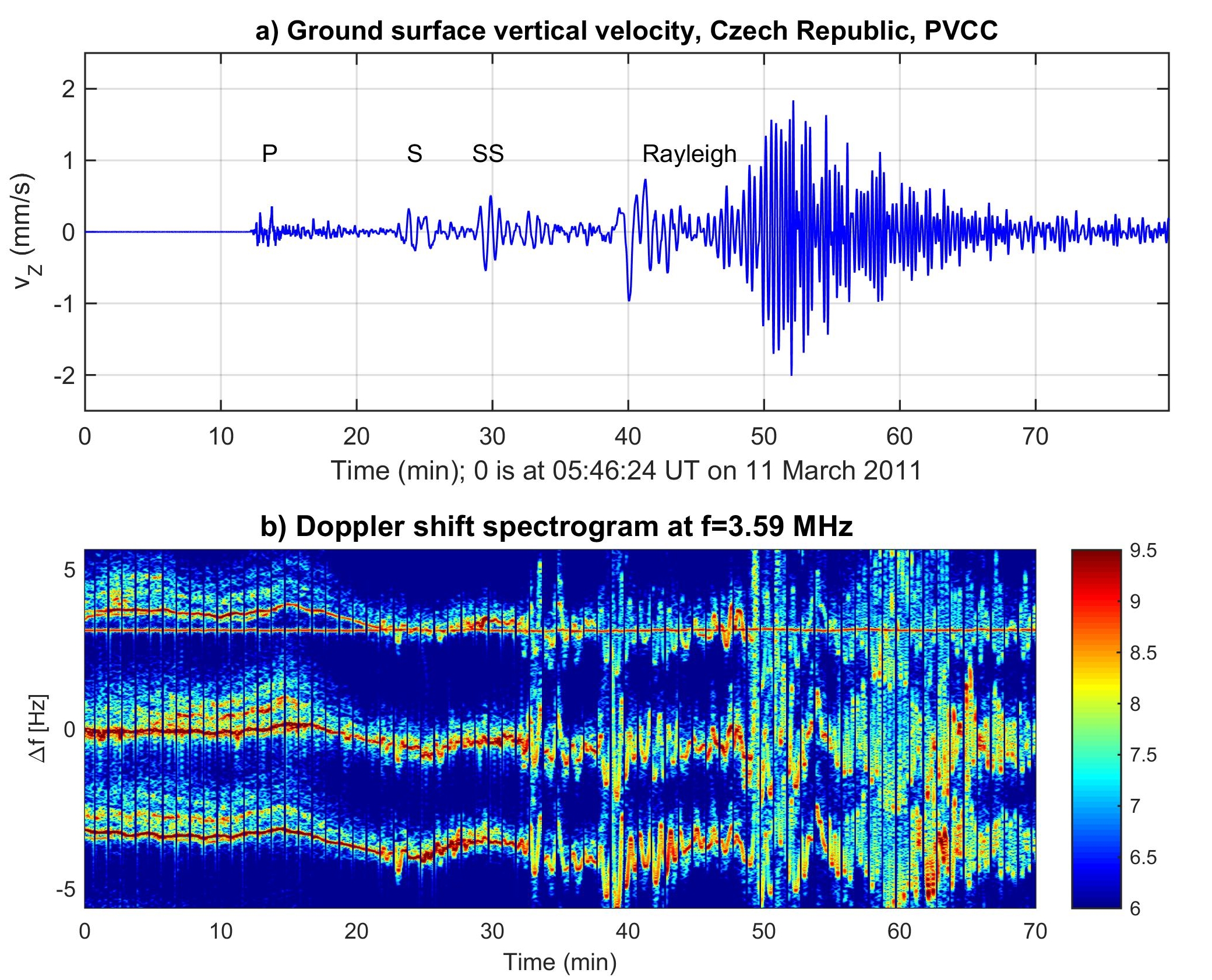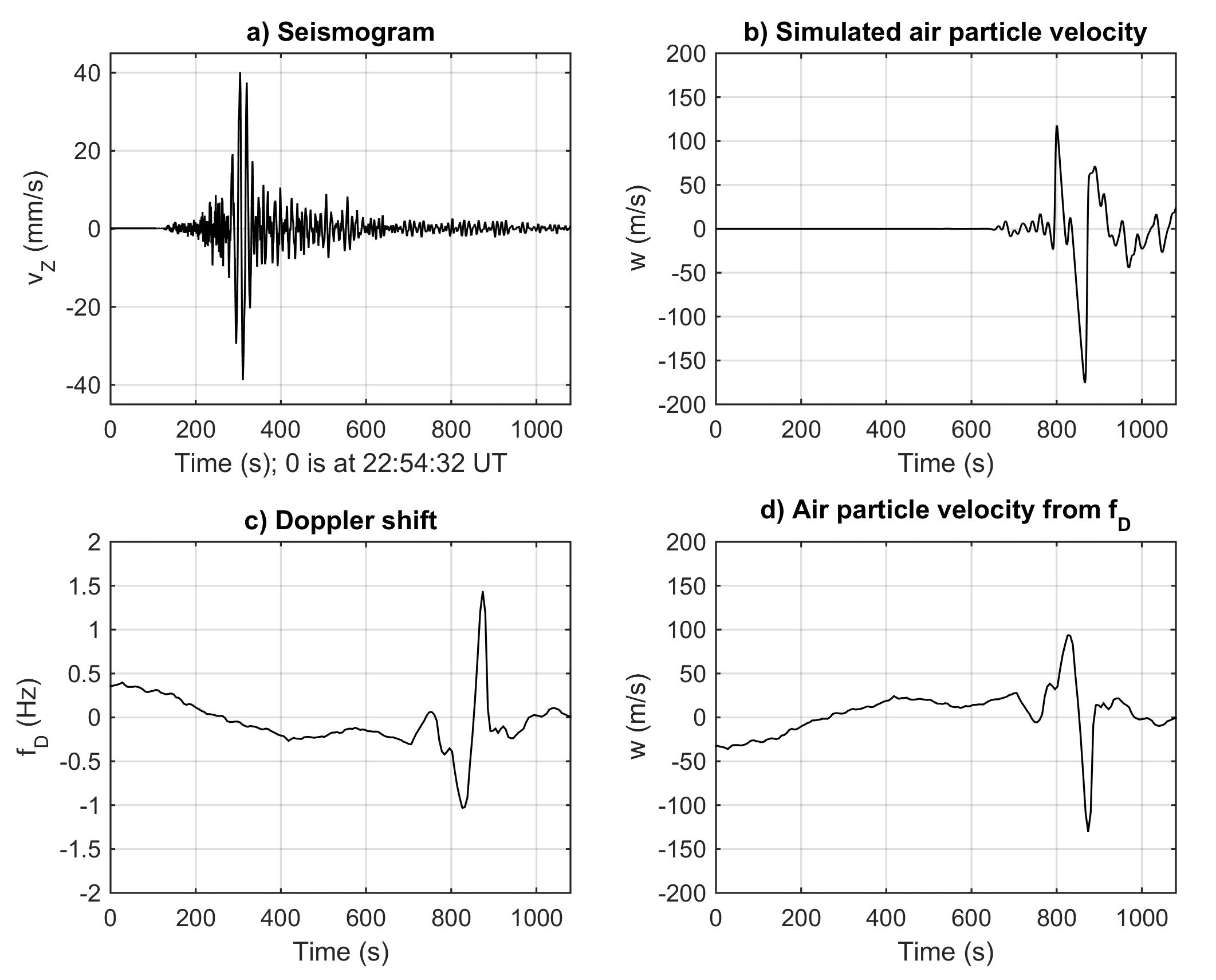1) Atmospheric Gravity Waves
Atmospheric gravity waves (GWs) propagate at frequencies lower than buoyancy frequency. They occur in the ionosphere very frequently and represent important coupling mechanism between different atmospheric layers and the ionosphere. Our research of GWs in the ionosphere is mainly based on our continuous Doppler shift measurements (suitable for investigation of small to medium scale GWs) and ionospheric sounding by digital portable sounder that is suitable for investigation of large scale waves.
Using multi-point continuous Doppler sounding in the Czech Republic, South Africa, Argentina and Taiwan, we found that propagation directions of medium scale GWs in the ionosphere exhibit seasonal variation according to propagation of neutral winds. GWs mostly propagated against the neutral wind. The meridian component of the observed propagation was mostly pole-ward in the local summer, whereas it was usually equator-ward during local winter. Doppler sounding at several different frequencies in combination with measurements of ionospheric profile, available in the Czech Republic, made it also possible to investigate the propagation of GWs in the ionosphere in 3-D. The observed medium scale GWs of periods ~10 to ~40 min usually propagated with phase velocities ~100-200 m/s directed obliquely downward, which means oblique upward propagation of energy (group velocity) for GWs. The observed attenuation with increasing height was usually in the range ~0.05-0.2 dB/km.
Chum, J., & Podolská, K. (2018). 3D analysis of GW propagation in the ionosphere. Geophysical Research Letters, 45, 11.562–11.571. https://doi.org/10.1029/2018GL079695
Fišer, J., J. Chum, and J.-Y. Liu (2017), Medium-scale traveling ionospheric disturbances over Taiwan observed with HF Doppler sounding, Earth, Planets and Space, 69:131, DOI 10.1186/s40623-017-0719-y
Chum, J., F.A.M. Bonomi, J. Fišer, M.A. Cabrera, R.G. Ezquer, D. Burešová, J. Laštovička, J. Baše, F. Hruška, M.G. Molina, J.E.Ise, J.I. Cangemi, and T. Šindelářová (2014), Propagation of gravity waves and spread F in the low-latitude ionosphere over Tucumán, Argentina, by continuous Doppler sounding: First results, J. Geophys. Res.Space Physics, 119, 6954–6965, doi:10.1002/2014JA020184.
Chum, J., R. Athieno, J. Base, D. Buresova, F. Hruska, J. Lastovicka, L.-A. McKinnell, and T. Sindelarova (2012), Statistical Investigation of Horizontal Propagation of Gravity Waves in the Ionosphere over Europe and South Africa, J. Geophys. Res., 117, A03312, doi:10.1029/2011JA017161.
2) Infrasound waves
Our investigation showed that the observation of infrasound in the ionosphere is rare. Only long-period infrasound, with periods longer than approximately 10 s, can reach the ionosphere; the shorter periods (higher frequencies) are significantly damped below the ionosphere. The infrasound observed in the ionosphere mostly originated from strong (M>7) earthquakes (coseismic infrasound) or severe tropospheric weather systems (typhoons, large convective systems, significant cold fronts etc).
Coseismic infrasound was observed as relatively compact wave packets (several minutes long) that could be associated with individual seismic waves packets that were observed below. The time delays between the observation of seismic waves on the ground and coseismic infrasound in the ionosphere are consistent with (quasi)vertical propagation, which is a consequence of supersonic propagation of seismic waves. At large distances from the epicenter, the waveforms on the ground and ionosphere might be similar. Figure 1 shows vertical component of the velocity of ground surface motion and Doppler record in the Czech Republic for 11 March 2011 Tohoku earthquake).

Figure 1 - vertical component of the velocity of ground surface motion and Doppler record in the Czech Republic for 11 March 2011 Tohoku earthquake).
At intermediate and short distances from the strong earthquakes, the amplitudes of infrasound waves in the upper atmosphere are so large that the nonlinear phenomena start playing an important role. It results in significant differences between spectra observed on the ground and in the upper atmosphere that cannot be explained by the linear approach, even if the attenuation of higher frequencies owing to viscosity and thermal conductivity is considered. Especially, at short distances the nonlinear phenomena might lead to formation of the N-shaped pulse that resembles a shock wave. Figure 2 shows situation for Chilean earthquake on 16 September 2015 and Doppler observation in Argentina, including comparison with numerical simulation.
Chum, J., J.-Y. Liu, K. Podolská, T. Šindelářová (2018), Infrasound in the ionosphere from earthquakes and typhoons, J. Atmos. Sol. Terr. Phys., 171, 72-82, doi:/10.1016/j.jastp.2017.07.022
Chum, J., M. A. Cabrera, Z. Mošna, M. Fagre, J. Baše, and J. Fišer (2016), Nonlinear acoustic waves in the viscous thermosphere and ionosphere above earthquake, J. Geophys. Res. Space Physics, 121, doi:10.1002/2016JA023450.
Liu, J. Y., C. H. Chen, Y. Y. Sun, C. H. Chen, H. F. Tsai, H. Y. Yen, J. Chum, J. Lastovicka, Q. S. Yang, W. S. Chen, and S. Wen (2016), The vertical propagation of disturbances triggered by seismic waves of the 11 March 2011 M9.0 Tohoku earthquake over Taiwan, Geophys. Res. Lett., 43, 1759–1765, doi:10.1002/2015GL067487.
Chum J., Y.-J. Liu, J. Laštovička, J. Fišer, Z. Mošna, J. Baše, Y.Y. Sun (2016), Ionospheric signatures of the April 25, 2015 Nepal earthquake and the relative role of compression and advection for Doppler sounding of infrasound in the ionosphere, Earth, Planets and Space, 68:24, DOI 10.1186/s40623-016-0401-9
Chum, J., F. Hruska, J. Zednik, and J. Lastovicka (2012), Ionospheric disturbances (infrasound waves) over the Czech Republic excited by the 2011 Tohoku earthquake, J. Geophys. Res., 117, A08319, doi:10.1029/2012JA017767.
Šindelářová, T., D. Burešová, J. Chum, and F. Hruška (2009), Doppler observations of infrasonic waves of meteorological origin at ionospheric heights. Adv. Space Res., 43, 1644-1651.
3) Planetary waves
In recent years we have focused on investigations of persistency of planetary waves, which occur in the form of bursts of several wave cycles, not as a permanent or long-term oscillation. Our results show that the persistency of planetary wave type oscillations in foF2 (i.e. in maximum ionospheric electron density) in northern middle latitudes is very similar in Europe, northern U.S.A., and northern Japan, typically 4 wave cycles for the 5-day wave, for the 10-day wave, it is rather 3.5 wave cycles, and for the 16-day wave, the typical persistence is no more than 3 wave cycles. In terms of the number of wave cycles in the planetary wave type events, the persistence decreases towards longer periods. However, the persistence of wave events in terms of days increases towards longer periods. There is a large temporal and partly spectral variability of the planetary wave type activity. The longitudinal size of the planetary wave type events increases with increasing period, making the 5-day and 10-day period events in Europe, America and Japan essentially dissimilar, and the 16-day oscillations much more similar among the three regions. The spectrum of event duration is very broad. The character of the spectrum does not allow predict the duration of an event when we observe its beginning or, say, first 2-3 wave cycles. While the typical persistence of the planetary wave type oscillations in foF2 and the lower ionosphere over Europe is similar, the correspondence of occurrence of individual events is rather poor.

